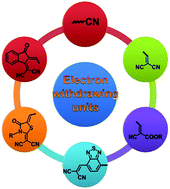The performance of organic solar cells based on nonfullerene acceptors is improving rapidly and nowadays the power conversion efficiencies of single-junction devices have achieved over 18%. Nonfullerene acceptors usually consist of electron-rich units and electron-deficient units, and the interaction between these two parts can widen the optical absorption, tune the energy levels and improve the film morphologies of acceptor materials. Among the various electron-withdrawing groups, cyano groups have been most used in the construction of electron-deficient units for nonfullerene acceptors. In this review, the electron-deficient units containing cyano groups for nonfullerene electron acceptors have been summarized, and the effects of these electron-deficient units on the photoelectric properties and photovoltaic performance of acceptor materials have been elaborated to extract some effective molecular design strategies for high-performance acceptor materials.
